Musophagidae – Turacos, Plantain-eaters & Go-away-birds
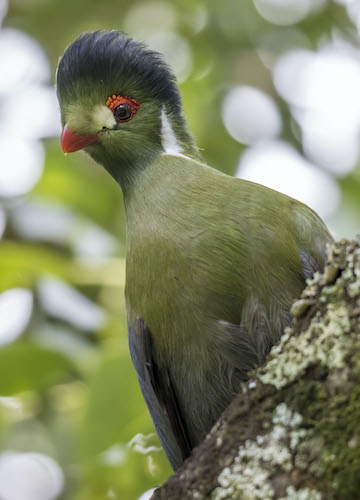
The Musophagidae, the sole family of the order Musophagiformes, (literally ‘banana-eaters’), or turacos, includes plantain-eaters and go-away-birds. In southern Africa both turacos and go-away-birds are commonly known as loeries. They are semi-zygodactylous – the fourth (outer) toe can be switched back and forth. The second and third toes, which always point forward, are conjoined in some species. Musophagids often have prominent crests and long tails; the turacos are noted for peculiar and unique pigments giving them their bright green and red feathers.
Traditionally, this group has been allied with the cuckoos in the order Cuculiformes, but the Sibley-Ahlquist taxonomy raised this group to a full order Musophagiformes. They have been proposed to link the hoatzin to the other living birds, but this was later disputed. Recent genetic analysis has strongly supported the order ranking.

Grey Go-away-bird Crinifer concolor – ©Dubi Shapiro
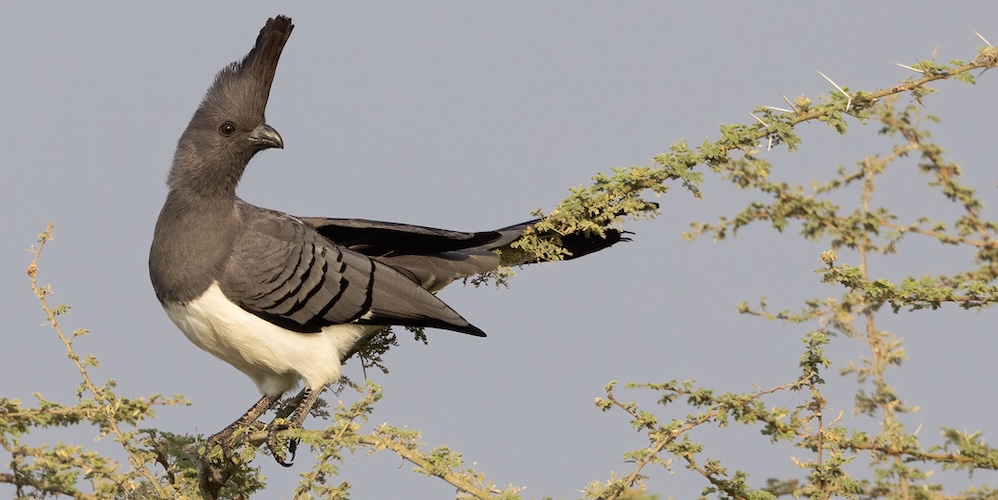
White-bellied Go-away-bird Crinifer leucogaster – ©Dubi Shapiro
Musophagids are medium-sized arboreal birds endemic to sub-Saharan Africa, where they live in forests, woodland and savanna. Their flight is weak, but they run quickly through the tree canopy. Frugivores, they feed mostly on fruits and to a lesser extent on leaves, buds, and flowers, occasionally taking small insects, snails, and slugs. As their name suggests, turacos enjoy bananas and can become so tame as to be hand-fed. They are also partial to grapes and pawpaw (papaya) and, especially, figs.
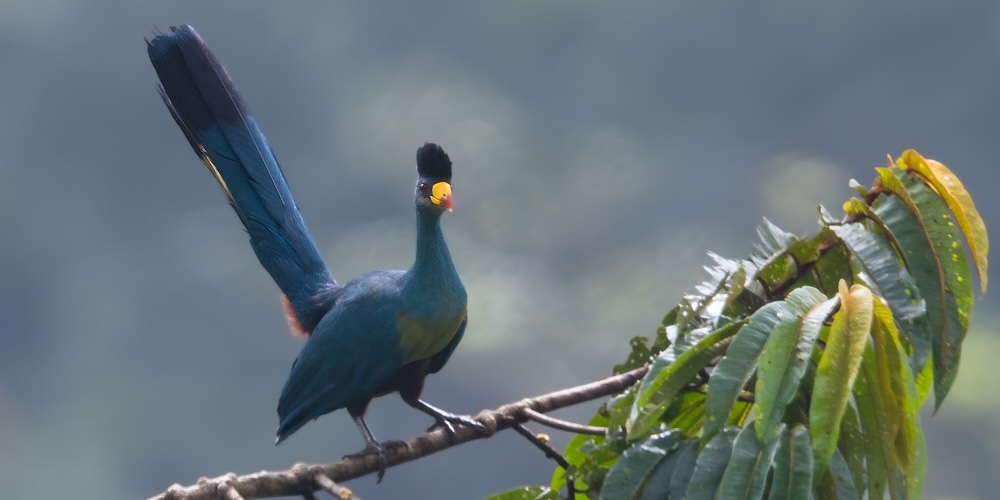
Great Blue Turaco Corythaeola cristata – ©Dubi Shapiro
They are gregarious birds that do not migrate, but move in family groups of up to ten. Many species are noisy, with the go-away-birds being especially noted for their piercing alarm calls, which alert other fauna to the presence of predators or hunters; their common name refers to this onomatopoeic call. They all build large stick nests in trees, and lay 2 or 3 eggs. The young are born with thick down and open, or nearly-open, eyes.
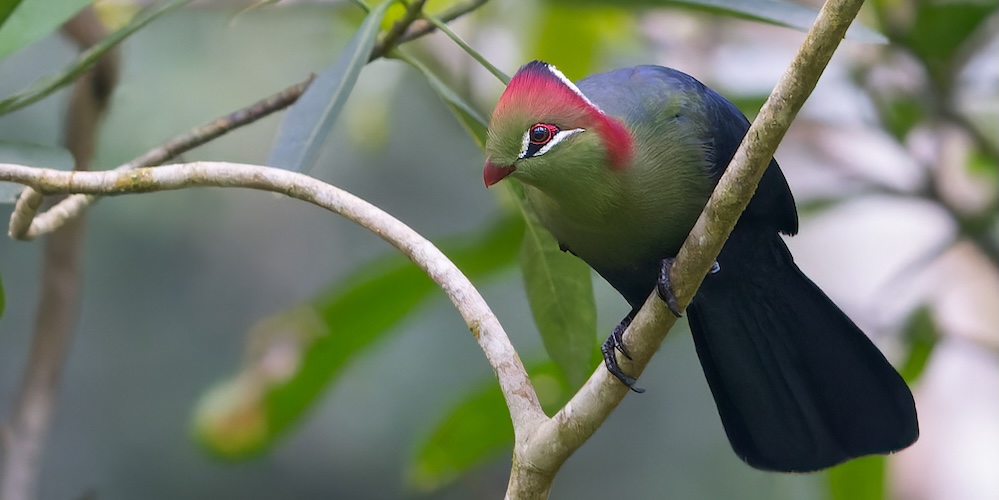
Fischer’s Turaco Tauraco fischeri – ©Dubi Shapiro
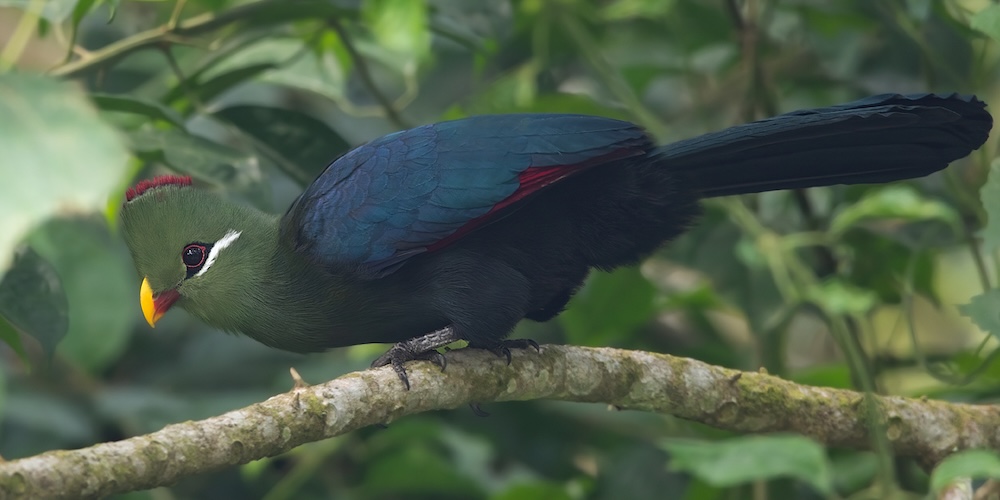
Yellow-billed Turaco Tauraco macrorhynchus – ©Dubi Shapiro
Most turacos are medium-sized birds, an exception being the large Great Blue Turaco, with long tails and short, rounded wings. They range in length from 40cm to 75cm. Their flight is weak, but they are strong climbers and are able to move nimbly on branches and through vegetation. Juveniles have claws on the wings that help them climb. They have a unique foot arrangement, where the fourth toe can be brought around to the back of the foot where it almost touches the first toe, or brought around so that it is near the second and third. In spite of this flexibility the toe is actually usually held at right angles to the axis of the foot.
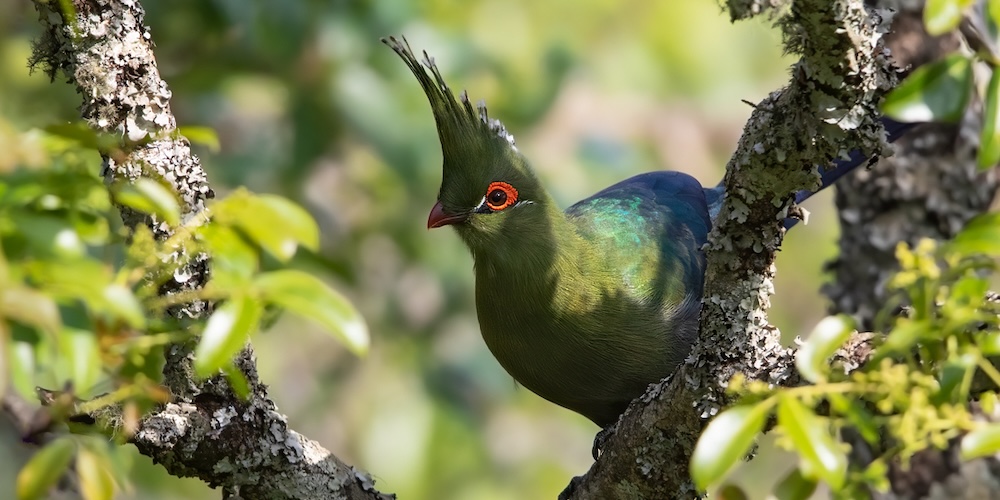
Schalow’s Turaco Tauraco schalowi – ©Dubi Shapiro
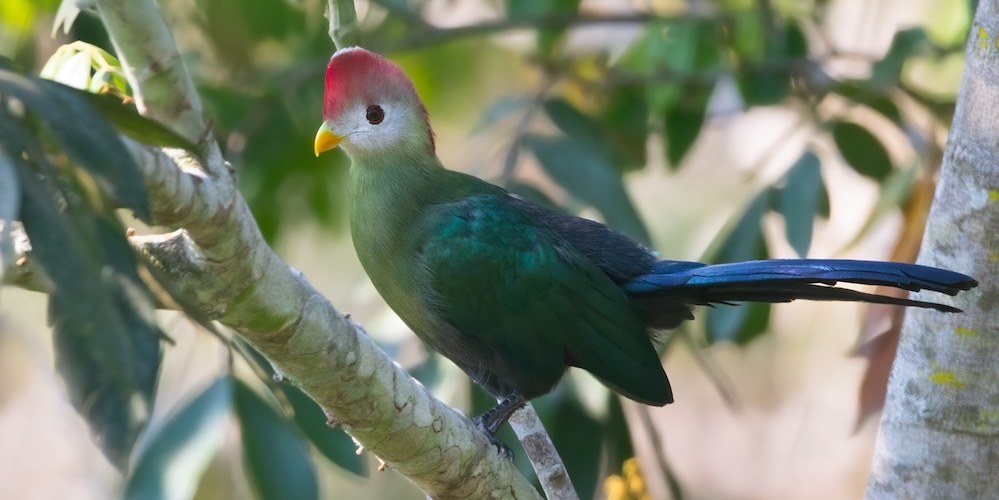
Red-crested Turaco Tauraco erythrolophus – ©Dubi Shapiro
The plumage of go-away-birds and plantain-eaters is mainly grey and white. The turacos on the other hand are brightly coloured birds, usually blue, green or purple. The green colour in turacos comes from turacoverdin, the only true green pigment in birds known to date. Other ‘greens’ in bird colours result from a yellow pigment such as some carotenoid, combined with the prismatic physical structure of the feather itself which scatters the light in a particular way and giving a blue colour. Turaco wings contain the red pigment turacin, unlike in other birds where red colour, which is also due to carotenoids. Both pigments are derived from porphyrins and only known from the Musophagidae at present, but especially the little-researched turacoverdin might have relatives in other birds. The incidence of turacoverdin in relation to habitat is of interest to scientists, being present in forest species but absent in savanna and acacia living species.
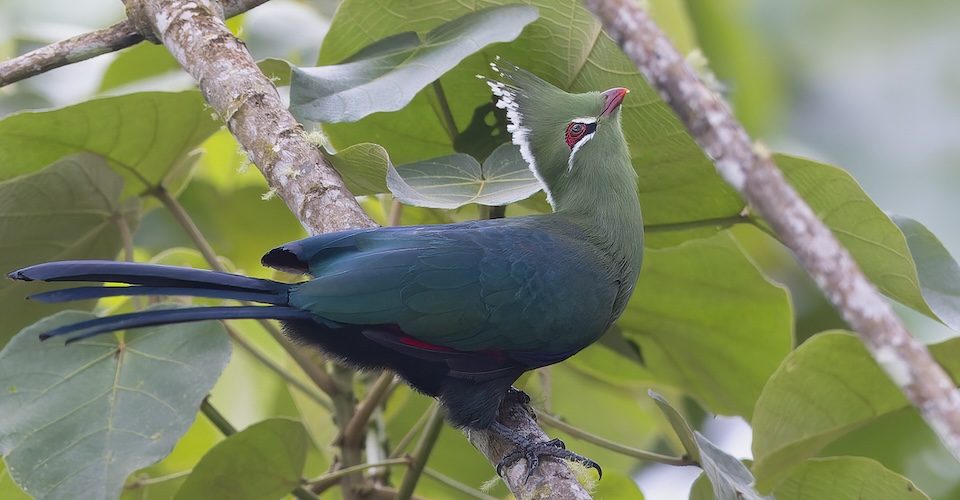
Livingstone’s Turaco Tauraco livingstonii – ©Dubi Shapiro
Little is known about the longevity of wild turacos, but in captivity they are proving to be exceptionally long-lived, easily living to 30 and beyond in captivity.
-
Number of bird species: 23
(As at August 2025)
According to the recently (2025) unified AviList there are 23 species in five genera in the Musophagidae family, which are the only Musophagiformes. They are:
Great Blue Turaco Corythaeola cristata
Grey Go-away-bird Crinifer concolor
Bare-faced Go-away-bird Crinifer personatus
White-bellied Go-away-bird Crinifer leucogaster
Western Plantain-eater Crinifer piscator
Eastern Plantain-eater Crinifer zonurus
Purple-crested Turaco Gallirex porphyreolophus
Ruwenzori Turaco Gallirex johnstoni
Ruspoli’s Turaco Menelikornis ruspolii
White-cheeked Turaco Menelikornis leucotis
Violet Turaco Tauraco violacea
Ross’s Turaco Tauraco rossae
Yellow-billed Turaco Tauraco macrorhynchus
Bannerman’s Turaco Tauraco bannermani
White-crested Turaco Tauraco leucolophus
Black-billed Turaco Tauraco schuettii
Schalow’s Turaco Tauraco schalowi
Red-crested Turaco Tauraco erythrolophus
Guinea Turaco Tauraco persa
Hartlaub’s Turaco Tauraco hartlaubi
Fischer’s Turaco Tauraco fischeri
Livingstone’s Turaco Tauraco livingstonii
Knysna Turaco Tauraco corythaix
-
International Turaco Society
WebsiteThe International Turaco Society was set up in 1993 by a group of Turaco enthusiasts who met at the Cotswold Wildlife Park in Burford (Oxfordshire in England). Anyone interested in any aspect of keeping or breeding Turacos is welcome to join. Our membership also includes corporate members such as public zoos and bird gardens
-
A Dictionary of the Turacos
| By Robert G Black | 2009 | Avian Publications | Paperback | 94 pages, b/w map | ISBN: 9780910335737 Buy this book from NHBS.com -
Turacos - A Natural History of the Musophagidae
| By Joseph M Forshaw & William T Cooper | 2002 | Nokomis Publications | Hardback | 223 pages, 26 col plates, 25 b/w plates | ISBN: 9780958174206 Buy this book from NHBS.com
-
Musophagidae
Family AccountMusophagidae is the sole family in Musophagiformes.... -
Musophagidae
Family AccountMusophagidae is one of very few bird families endemic to Africa, one other being the mousebirds, Colliidae. All species are frugivorous, but they also eat
Although this is a medium-sized family with twenty-three species in five genera, Fatbirder provides a limited number of active links below to each species.
-
Bannerman’s Turaco Tauraco bannermani
Species AccountSound archive and distribution map, etc. -
Bannerman’s Turaco Tauraco bannermani
Species AccountA long-tailed, bulky greenish turaco with a yellow bill, a red crest, and gray cheeks. -
Bare-faced Go-away-bird Corythaixoides personatus
Species AccountThe bare-faced go-away-bird (Corythaixoides personatus) is a species of bird in the family Musophagidae which is native to the eastern Afrotropics. -
Bare-faced Go-away-bird Corythaixoides personatus
Species AccountSound archive and distribution map, etc. -
Black-billed Turaco Tauraco schuettii
Species AccountSpectacular green crested turaco. Shows large crimson wing patches in flight. Found in rainforest and gallery forest. -
Black-billed Turaco Tauraco schuettii
Species AccountSound archive and distribution map, etc. -
Eastern Plantain-eater Crinifer zonurus
Species AccountThe eastern plantain-eater, Crinifer zonurus, also known as the eastern grey plantain-eater, is a large member of the turaco family, a group of large arboreal near-passerine birds restricted to Africa. -
Eastern Plantain-eater Crinifer zonurus
Species AccountSound archive and distribution map, etc. -
Fischer’s Turaco Tauraco fischeri
Species AccountThis species occurs in Kenya, north-eastern Tanzania and southern Somalia. They live in forest and wooded thickets, preferring areas with mature fruiting trees. Pairs of Fischer's turacos establish a breeding territory which they will defend fiercely against any mammals which get too close. -
Fischer’s Turaco Tauraco fischeri
Species AccountSound archive and distribution map, etc. -
Great Blue Turaco Corythaeola cristata
Species AccountSound archive and distribution map, etc. -
Great Blue Turaco Corythaeola cristata
Species AccountThe great blue turaco (Corythaeola cristata) is a turaco, a group of African near-passerines. It is the largest species of turaco. -
Great Blue Turaco Corythaeola cristata
Species AccountThe largest member of the Turaco family, the Great Blue measures around 70-75 cm long and usually weighs between 822-1231 grams. -
Grey Go-away-bird Corythaixoides concolor
Species AccountThe grey go-away-bird (Corythaixoides concolor), also known as grey lourie, grey loerie, or kwêvoël, is a bold and common bird of the southern Afrotropics. -
Guinea Turaco Tauraco persa
Species AccountThe Guinea turaco (Tauraco persa), also known as the green turaco or green lourie, is a species of turaco, a group of African otidimorph birds. -
Guinea Turaco Tauraco persa
Species AccountSound archive and distribution map, etc. -
Hartlaub’s Turaco Tauraco hartlaubi
Species AccountHartlaub's turaco (Tauraco hartlaubi) is a species of bird in the family Musophagidae. It is found in Kenya, Tanzania, and Uganda. -
Hartlaub’s Turaco Tauraco hartlaubi
Species AccountSound archive and distribution map, etc. -
Knysna Turaco Tauraco corythaix
Species AccountThe Knysna turaco (Tauraco corythaix), or, in South Africa, Knysna lourie, is a large turaco, one of a group of African near-passerine birds. It is a resident breeder in the mature evergreen forests of southern and eastern South Africa, and Swaziland. -
Knysna Turaco Tauraco corythaix
Species AccountSound archive and distribution map, etc. -
Livingstone’s Turaco Tauraco livingstonii
Species AccountSound archive and distribution map, etc. -
Livingstone’s Turaco Tauraco livingstonii
Species AccountLivingstone's turaco (Tauraco livingstonii) is a species of bird in the family Musophagidae, which was named for Charles Livingstone, the brother of David... -
Purple-crested Turaco Gallirex porphyreolophus
Species AccountThe purple-crested turaco (Gallirex porphyreolophus) or, in South Africa, the purple-crested loerie, (Khurukhuru in the Luvenḓa (Venḓa) language is a species... -
Purple-crested Turaco Gallirex porphyreolophus
Species AccountSound archive and distribution map, etc. -
Red-crested Turaco Tauraco erythrolophus
Species AccountA long-tailed, bulky greenish turaco with a yellow bill, a red crest (sometimes tipped white) extending down the nape, and a whitish face. -
Red-crested Turaco Tauraco erythrolophus
Species AccountSound archive and distribution map, etc. -
Ross's Turaco Musophaga rossae
Species AccountRoss's turaco or Lady Ross's turaco (Musophaga rossae) is a mainly bluish-purple African bird of the turaco family, Musophagidae. -
Ruspoli’s Turaco Menelikornis ruspolii
Species AccountIt is endemic to southern Ethiopia where its natural habitat is subtropical or tropical dry forests. It is threatened by habitat loss. -
Ruspoli’s Turaco Menelikornis ruspolii
Species AccountSound archive and distribution map, etc. -
Ruwenzori Turaco Ruwenzorornis johnstoni
Species AccountThe Ruwenzori turaco (Ruwenzorornis johnstoni) is a species of bird in the Musophagidae family. It is monotypic within the genus Ruwenzorornis.[2] It is found in Burundi, Democratic Republic of the Congo, Rwanda, and Uganda. -
Ruwenzori Turaco Ruwenzorornis johnstoni
Species AccountSound archive and distribution map, etc. -
Schalow’s Turaco Tauraco schalowi
Species AccountSchalow's turaco (Tauraco schalowi) is a frugivorous bird in the family Musophagidae. -
Schalow’s Turaco Tauraco schalowi
Species AccountSound archive and distribution map, etc. -
Violet Turaco Musophaga violacea
Species AccountThe violet turaco, also known as the violaceous plantain eater (Musophaga violacea), is a large turaco, a group of African near-passerines. It is resident in West Africa, and has an extremely large range from Senegal through to the Nigeria, with an isolated population in Chad and Central African Republic. -
Western Plantain-eater Crinifer piscator
Species AccountThe western plantain-eater (Crinifer piscator), also known as the grey plantain-eater or western grey plantain-eater, is a large member of the turaco family, a group of large arboreal near-passerine birds restricted to Africa. -
White-bellied Go-away-bird Corythaixoides leucogaster
Species AccountThe white-bellied go-away-bird (Corythaixoides leucogaster) is a bird of eastern Africa in the turaco family. -
White-cheeked Turaco Menelikornis leucotis
Species AccountSound archive and distribution map, etc. -
White-cheeked Turaco Menelikornis leucotis
Species AccountA spectacular green turaco with a bushy crest. There are two white marks on the face, though these vary geographically in size. -
White-crested Turaco Tauraco leucolophus
Species AccountBeautiful turaco with a mostly white head, a black mark above the eye, dark blue wings and tail, and a green back and underparts. -
White-crested Turaco Tauraco leucolophus
Species AccountSound archive and distribution map, etc. -
Yellow-billed Turaco Tauraco macrorhynchus
Species AccountA small green turaco with a yellow bill that inhabits lowland forests in West and Central Africa. -
Yellow-billed Turaco Tauraco macrorhynchus
Species AccountSound archive and distribution map, etc.
